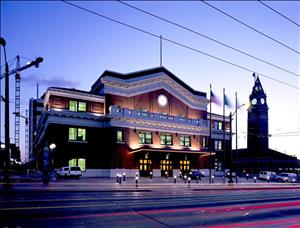On October 16, 1999, Seattle's historic Union Station is formally rededicated as the headquarters of the Sound Transit, the regional transit authority for King, Pierce, and Snohomish counties. The building was restored and adapted as part of a larger project directed by Union Station Associates, LLC, a partnership between Paul Allen's Vulcan Inc. and Nitse-Stagen & Company, developer of the former Sears Building, among other projects.
Union Station was built in 1911 as the Oregon & Washington Railroad Station to serve the Union Pacific Railroad and Milwaukee Road. Passenger rail service was consolidated in the nearby King Street Station by Amtrak in 1971, and Union Station was vacated except for occasional special events in its vast barrel-roofed waiting room. The facility was the subject of numerous studies for a possible "multi-modal" transportation center for rail, light rail, and bus services. This vision was partially realized with the opening of the adjacent International District Station of the Downtown Seattle Transit Tunnel in 1990.
The voters of King, Pierce and Snohomish counties approved creation of a regional transportation agency, Sound Transit, and a $3.9 billion rail and bus plan on November 5, 1996. The board of Sound Transit agreed on June 19, 1998, to locate its executive offices in Union Station. Nitze-Stagen organized the $21-million project, which involved NBBJ as the interior architects, Ron Wright & Associates as the exterior architects, Baugh Construction Co. as the general contractor, Maria Barrientos as project manager for Sound Transit under ST Property Manager Jeri Cranney, and scores of artisans and craftspeople.
The building re-opened on the evening of October 16, 1999, with a gala benefit for Historic Seattle and the release of a commemorative history prepared by History Ink. Shortly before the event, Sound Transit Board president Paul Miller commented, "We've asked how history will judge us. I see the restored Union Station as a symbol of the answer. We will be remembered by what we as an agency and we as a community can achieve. I believe that at the end of the next century, Union Station will stand as a tribute to a generation that stopped talking about the transportation problems that threaten our region and acted upon them."

